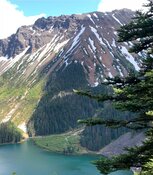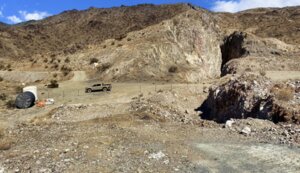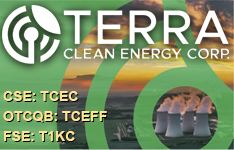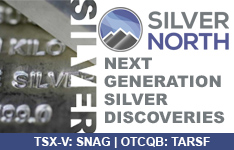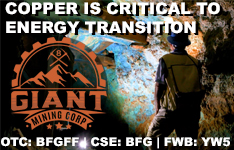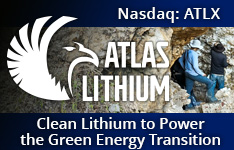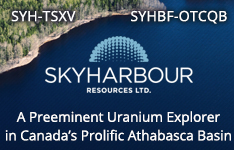Blue Lagoon Resources Inc. (BLLG:CSE; BLAGF:OTCQB; 7BL:FSE) announced it officially opened its wholly owned Dome Mountain gold mine project, which recently secured a mining permit, positioning it as one of the few high-grade, road-accessible gold projects in British Columbia to achieve production-ready status in recent years.
The opening event on July 9 drew over 100 attendees from across Canada and places as diverse as Germany, South Carolina, Denver, Montana, and Toronto, to commemorate the achievement, the company said.
The ceremony was enriched by the presence of 18 hereditary chiefs and guardians from the Lake Babine Nation, including hereditary chief and council member Fabian Michell. They performed a traditional drum ceremony featuring songs from all four Lake Babine Nation clans: Bear, Beaver, Frog, and Caribou.
"We were deeply honored to stand alongside the Lake Babine Nation, whose presence and participation made this day truly meaningful," said Blue Lagoon President and Chief Executive Officer Rana Vig. "This is more than just the opening of a gold mine — it's a moment that reflects years of hard work, resilience, and respectful collaboration."
Distinguished guests included the Mayor of Smithers, Gladys Atrill; MLA Sharon Hartwell from Bulkley Valley-Stikine; and MP Ellis Ross from Skeena-Bulkley Valley, along with various representatives from the Ministry of Mines and Critical Minerals and other provincial bodies.
Although Minister of Mining and Critical Minerals Jagrup Brar could not attend due to his commitments at the annual Conference of Mines Ministers of Canada in Prince Edward Island, he contributed a recorded message that highlighted the project's significance, which was played during the festivities. Brar is expected to visit the Dome Mountain site later in the month.
Preproduction Activities Starting Soon
During the two-day event, guests were offered underground tours and visited the newly completed, state-of-the-art water treatment plant, which is equipped to treat over six times the current needs at Dome Mountain, ensuring long-term environmental sustainability as production increases.
With the mine now officially open, preproduction activities are set to commence next week, paving the way for mining operations to begin and transition to near-term cash flow once the Moving Bed biofilm reactor (MBBR) system is commissioned, expected in about four weeks, Blue Lagoon said in its release.
The two-stage water treatment facility includes a functioning high-density sludge (HDS) circuit and the MBBR circuit, which employs microbes to eliminate blasting-related ammonia and nitrates. The biological ramp-up phase of the MBBR typically takes around four weeks, after which mining will start immediately.
"As a geologist, this is a proud moment in my career," said Bill Cronk, chief geologist and project manager at Blue Lagoon Resources. "To see a project go from exploration to production — and to be part of that transformation — is something most geologists only dream of. This team made it happen, and I'm very proud of that."
The event also welcomed strategic investors and partners, including Dr. Quinton Hennigh, technical adviser to Crescat Capital; and Peter Espig, CEO of Nicola Mining; with whom Blue Lagoon has a long-term toll milling agreement.
"Dome Mountain represents what's possible when entrepreneurial determination meets responsible mining practices," Nicola Mining CEO Peter Espig. "We're proud to support Blue Lagoon in bringing this project to life, and to be part of a partnership grounded in trust, transparency, and technical excellence."
Production Slated for September
With preproduction work beginning the week of July 21, Blue Lagoon Resources is now positioned to become one of British Columbia's next producing high-grade gold mines, the company said.
According to a July 10 report for Mining.com by Bruno Vendit, the opening of the mine comes more than 30 years after the last major mining activity at the property.
In February 2025, Blue Lagoon secured its mining and effluent/discharge permits from the British Columbia government, marking it as one of only nine entities to achieve such authorization in the province since 2015, Vendit reported. Following the inaugural ceremony, Blue Lagoon Resources' stock climbed 3.13% to CA$0.66.
In a July 4 updated research note, Fundamental Research Corp.'s Sid Rajeev noted the firm was resuming coverage of Blue Lagoon after the company secured the permit for Dome, a "significant milestone."
With the water treatment facility nearing full operation, Blue Lagoon anticipates a production rate of about 150 tonnes daily, amounting to 55,000 tonnes annually, and expects to recover approximately 15,000 ounces of gold in its first year, according to the Mining.com report. Initial blasting is slated for August, with the commencement of gold production projected for September. The company is on track to achieve full operational capacity by year-end.
Mining activities will commence at the Boulder Vein above the 1,290-meter level, employing a mechanized cut-and-fill approach.
"Over the past few years, we have strategically invested more than CA$30 million into Dome Mountain, ensuring that when we reached this milestone, we would be ready to move forward with minimal additional capital requirements," Vig said in a February 12 shareholder letter. "Now, with just approximately CA$3 million in additional CapEx, we will be in a position to begin mining operations — a remarkably low cost compared to industry norms."
The project enjoys the advantage of year-round road access and a newly operational water treatment plant. Blue Lagoon remains debt-free, with the forthcoming scale-up partially financed through a recently concluded funding round of nearly CA$5 million, Vendit noted. Additionally, the company has CA$3.6 million in cash from warrants and access to an unsecured credit line from its toll mill partner, Nicola Mining.
Local support has been pivotal to the revival of Dome Mountain. Four of the 10 current site workers are members of the Lake Babine First Nation, located on the traditional territory where the project is situated, the report said. As part of its collaboration with the Indigenous community, the company commits to providing scholarships to train Indigenous youth for underground mining roles.
The existing mine plan, which spans five years, is currently limited to the permitted Boulder Vein area, Vendit wrote. Blue Lagoon intends to seek additional permits to access deeper zones below the 1,290-meter level and to expand into the nearby Argillite Vein. This next phase of development could significantly boost production if exploration results are positive.
The history of gold mineralization on the property dates back to the late 1800s, with extensive surface and underground work completed by 1923–1924. A resurgence of exploration in the 1980s led to the discovery of the Boulder Vein system in 1985 by Noranda.
Project Is 'Something Special'
In a Live Market Call with Crescat Capital on July 11, Hennigh said he was intrigued by the deposit style, "a subset of alkaline gold systems called "a carbonate-based metal gold deposit."
"Do I think (the project) is something special? I do," said Hennigh, who noted telling the company it's tough for a junior company to get permits for such a mine.
"They managed to pull it off," he said. "For a junior company, this is an extraordinary feat. They should be congratulated to the fullest."
In an April analysis, Technical Analyst Clive Maund evaluated Blue Lagoon's fundamentals and assigned the company a Buy rating. Maund observed that after breaking out from a prolonged low base pattern in February, which followed a severe bear market from the early 2020 highs, Blue Lagoon's new bull market is just beginning to unfold.
In a June discussion with Streetwise Reports, Maund expressed optimism about the stock's trajectory, stating, "We should see dramatic acceleration to the upside." He added, "It is thought likely that [the price] will race towards the early 2020 highs, with CA$2.10 as an initial objective."
Research Firm Resumes Coverage
In a July 4 updated research note, Fundamental Research Corp.'s Sid Rajeev noted the firm was resuming coverage of Blue Lagoon after the company secured the permit for Dome, a "significant milestone."
"Dome Mountain is only one of nine mining projects in B.C. to receive a permit over the past decade, underscoring the rarity of such approvals in a province known for its rich mineral endowment and stringent permitting process," wrote Rajeev, who rated the stock a Buy with a Fair Value price of CA$1.11 per share.
"With preproduction starting soon, and commercial production expected by Q4-2025, we believe BLLG is well-positioned to generate strong cash flows from a modest but high-grade operation," the analyst said. "Given favorable gold market conditions, and upcoming operational milestones, we maintain a positive outlook, and view BLLG as a compelling opportunity in the junior mining space."
The Catalyst: Housing Starts Released Friday
Recent figures from the Commerce Department, released on Friday, indicate that housing starts increased by 4.6% in June to a seasonally adjusted annual rate of 1.321 million units, a rise from May’s revised rate of 1.263 million.
Despite these developments in the housing sector, the gold market has shown minimal response, hovering near session highs. Spot gold was last seen trading at US$3,357.80 an ounce, marking an increase of 0.58% for the day, Christensen wrote.
Gold, traditionally a staple on Main Street, has recently surpassed the Euro to become the second most held reserve currency by central banks globally.
 Streetwise Ownership Overview*
Streetwise Ownership Overview*
Blue Lagoon Resources Inc. (BLLG:CSE; BLAGF:OTCQB;7BL:FSE)
Goldman Sachs maintains a positive forecast, predicting gold prices will reach US$3,700 by the end of 2025 and continue to climb to US$4,000 by 2026.
Meanwhile, asset management firm Incrementum AG anticipates gold reaching US$4,800 by 2030, with potential to soar to US$8,900 under inflationary pressures. On a more cautious note, Citi predicts gold prices will range from US$3,100 to US$3,500 in the third quarter of 2025, with an expected decline to between US$2,500 and US$2,700 by the close of 2026, according to Reuters.
Ownership and Share Structure
According to Blue Lagoon Resources' Investor Presentation, founders and insiders own 14% of the company. There are three strategic investors, Crescat Capital with 8%, Nicola Mining Inc. with 6% and Phoenix Gold Fund with 6%.
The remaining 66% of Blue Lagoon is in retail.
The soon-to-be-gold producer has 140.78 million issued and outstanding shares. Its market cap is CA$96.2 million. Its 52-week range is CA$0.10–0.87 per share.
| Want to be the first to know about interesting Gold investment ideas? Sign up to receive the FREE Streetwise Reports' newsletter. | Subscribe |
Important Disclosures:
- As of the date of this article, officers and/or employees of Streetwise Reports LLC (including members of their household) own securities of Blue Lagoon Resources Inc.
- Steve Sobek wrote this article for Streetwise Reports LLC and provides services to Streetwise Reports as an employee.
- This article does not constitute investment advice and is not a solicitation for any investment. Streetwise Reports does not render general or specific investment advice and the information on Streetwise Reports should not be considered a recommendation to buy or sell any security. Each reader is encouraged to consult with his or her personal financial adviser and perform their own comprehensive investment research. By opening this page, each reader accepts and agrees to Streetwise Reports' terms of use and full legal disclaimer. Streetwise Reports does not endorse or recommend the business, products, services or securities of any company.
For additional disclosures, please click here.

